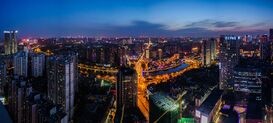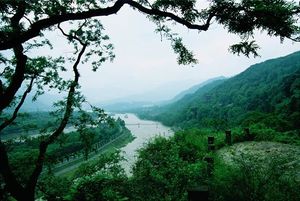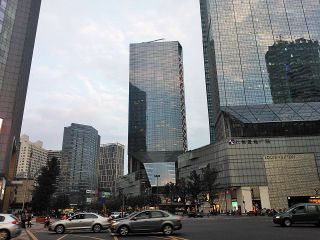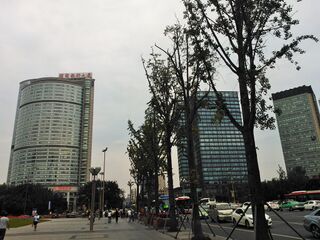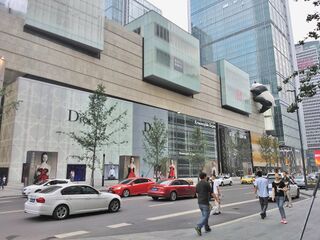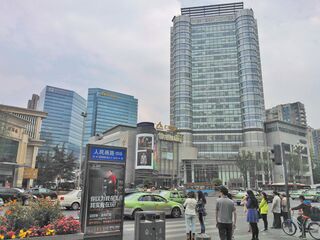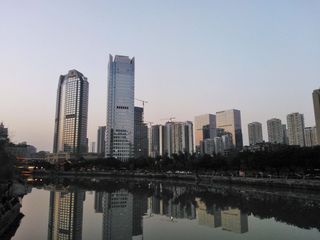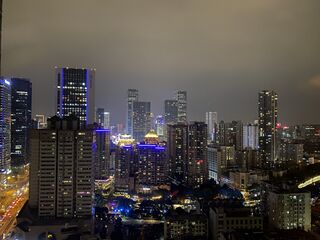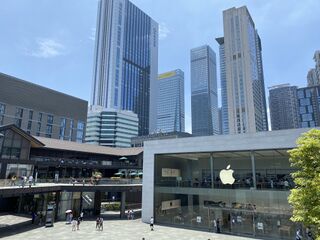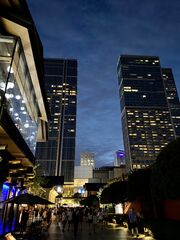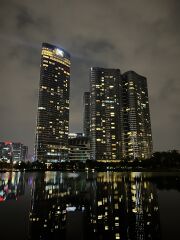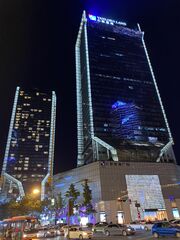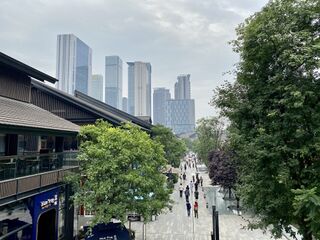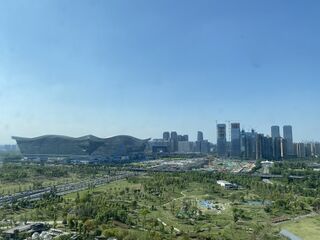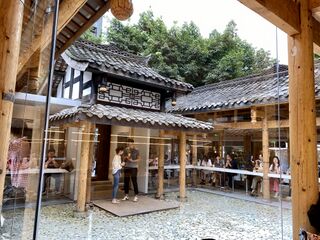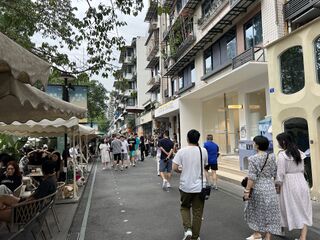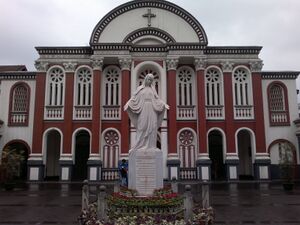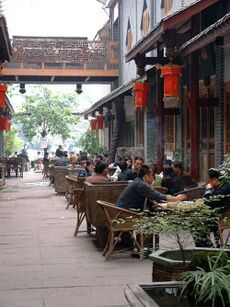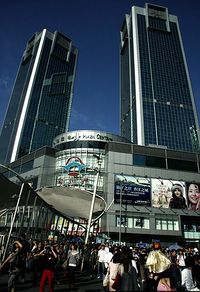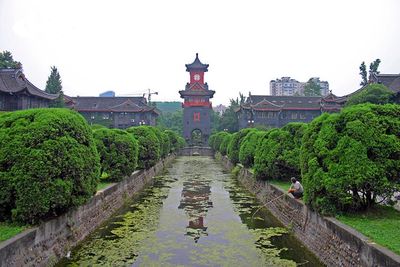چنگدو
| ||||||||||||||||||||||||||||||||||||||||||||||||||||||||||||||||||||||||||||||||||||||||||||||||||||||||||||||||||||||||||
| ||||||||||||||||||||||||||||||||||||||||||||||||||||||||||||||||||||||||||||||||||||||||||||||||||||||||||||||||||||||||||
چنگدو أو تشنغدو (المندرينية الفصحى: [tʂʰə̌ŋ.tú] (![]() استمع))، الرومنة السابقة: Chengtu، هي مدينة دون المقاطعة عملت كعاصمة لمقاطعة سيچوان بالصين. وهي واحدة من أكبر ثلاث مدن عداداً في غرب الصين، المدينتان الآخرتان هما تشونگچينگ و شيآن. اعتبارا من 2014[تحديث]، تضم المنطقة الادارية 14,427,500 نسمة، بتعداد حضري 10,152,632. وفي وقت تعداد 2010، كانت چنگدو خامس أكبر تجمع سكاني في الصين، بتعداد 10,484,996 نسمة في المنطقة المبنية التي تضم ناحية شينجين و مدينة گوانگهان في دىيانگ.
استمع))، الرومنة السابقة: Chengtu، هي مدينة دون المقاطعة عملت كعاصمة لمقاطعة سيچوان بالصين. وهي واحدة من أكبر ثلاث مدن عداداً في غرب الصين، المدينتان الآخرتان هما تشونگچينگ و شيآن. اعتبارا من 2014[تحديث]، تضم المنطقة الادارية 14,427,500 نسمة، بتعداد حضري 10,152,632. وفي وقت تعداد 2010، كانت چنگدو خامس أكبر تجمع سكاني في الصين، بتعداد 10,484,996 نسمة في المنطقة المبنية التي تضم ناحية شينجين و مدينة گوانگهان في دىيانگ.
سهل چنگدو المحيط بالمدينة يُعرف أيضاً بإسم "بلد النعيم" (الصينية: 天府之国; پنين: Tiānfǔ zhi Guó) و "بلد الوفرة". مستوطنوها قبل التاريخ يضمون ثقافة سانشينگدوي. أسستها دولة شو قبل اندماجها في الصين، وتتميز چنگدو كمستوطنة صينية رئيسية احتفظت بإسمها (تقريباً) بدون تغيير طوال العصور الامبراطورية والجمهورية والشيوعية. وكانت عاصمة ليو بـِيْ في شو في عصر الممالك الثلاث، وكذلك لعدد من الممالك المحلية في العصور الوسطى.[بحاجة لمصدر] بعد سقوط نانجينگ في أيدي اليابانيين في 1937، عملت چنگدو كعاصمة الصين. وهي الآن واحدة من أهم المراكز الاقتصادية والمالية والثقافية والمواصلاتية والاتصالاتية في غرب الصين. مطار چنگدو شوانگليو الدولي، مركز كلٍ من إير تشاينا و سيچوان للخطوط الجوية هو واحد من 30 أزحم مطار في العالم، و محطة سكك حديد چنگدو هي واحدة من أكبر ستة في الصين. كما تستضيف چنگدو العديد من الشركات العالمية وأكثر من 12 قنصلية. أكثر من 260 شركة على قائمة فورتشن 500 لها فروع في چنگدو.
تعتبر مدينة حاضرة مقاطعة سيتشوان جنوب غربي الصين.
Chengdu (UK: /tʃɛŋˈduː/, US: /tʃʌŋ-/;[5] simplified Chinese: 成都; pinyin: Chéngdū; Sichuanese pronunciation: [tsʰən˨˩tu˥], Standard Chinese pronunciation: [tʂʰə̌ŋ.tú] (![]() استمع)), alternatively romanized as Chengtu, is a sub-provincial city which serves as the capital of the Chinese province of Sichuan. With a population of 20,937,757 inhabitants during the 2020 Chinese census,[6] it is the fourth most populous city in China, and it is the only city apart from the four direct-administered municipalities with a population of over 20 million. It is traditionally the hub of Western China.
استمع)), alternatively romanized as Chengtu, is a sub-provincial city which serves as the capital of the Chinese province of Sichuan. With a population of 20,937,757 inhabitants during the 2020 Chinese census,[6] it is the fourth most populous city in China, and it is the only city apart from the four direct-administered municipalities with a population of over 20 million. It is traditionally the hub of Western China.
Chengdu is located in central Sichuan. The surrounding Chengdu Plain is known as the "Country of Heaven" (الصينية: 天府之国; پنين: Tiānfǔ zhi Guó) and the "Land of Abundance". Its prehistoric settlers included the Sanxingdui culture. The site of Dujiangyan, an ancient irrigation system, is designated as a World Heritage Site.[7] The Jin River flows through the city. Chengdu's culture largely reflects that of its province, Sichuan; in 2011, it was recognized by UNESCO as a city of gastronomy.[8] It is associated with the giant panda, a Chinese national symbol, which inhabits the area of Sichuan; the city is home to the Chengdu Research Base of Giant Panda Breeding.
Founded by the state of Shu, Chengdu is unique as a major Chinese settlement that has maintained its name mostly unchanged throughout the imperial, republican, and communist eras. It was the capital of Liu Bei's Shu Han during the Three Kingdoms Era, as well as several other local kingdoms during the Middle Ages.[9] During World War II, refugees from eastern China fleeing from the Japanese settled in Chengdu. After the war, Chengdu was briefly the capital of the Nationalist republican government until it withdrew to Taipei on the island of Taiwan. Under the PRC, Chengdu's importance as a link between Eastern and Western China expanded, with railways built to Chongqing in 1952, and Kunming and Tibet afterward.[9] In the 1960s, Chengdu became an important defense industry hub.
Chengdu is now one of the most important economic, financial, commercial, cultural, transportation, and communication centers in China. Its economy is diverse, characterized by the machinery, automobile, medicine, food, and information technology industries. Chengdu Shuangliu International Airport, and the newly built Tianfu International Airport, a hub of Air China and Sichuan Airlines, is one of the 30 busiest airports in the world, and the Chengdu railway station is one of the six biggest in China. Chengdu is considered a "Beta + (global second-tier)" city classification (together with Barcelona and Washington, D.C.) according to the Globalization and World Cities Research Network.[10] Chengdu is a leading financial hub, ranking 35th globally the 2021 Global Financial Centres Index.[11] Chengdu also hosts many international companies; more than 300 Fortune 500 companies have established branches in Chengdu.[12] The city also hosts more than 16 foreign consulates, making it the fourth major city to host more foreign representatives than any other city in China after Beijing, Shanghai, and Guangzhou.[13] Chengdu is the seat of the Western Theater Command region of the People's Liberation Army.[14] Chengdu hosted the FISU Summer World University Games, an international multi-sport event. It is considered one of the most livable cities in China.[15][16]
Chengdu is one of the world's top 30 cities by scientific research output,[17] and home to the greatest number of universities and research institutes in Southwestern China, notably Sichuan University, University of Electronic Science and Technology of China, Southwestern University of Finance and Economics, Southwest Jiaotong University, Chengdu University of Technology, Sichuan Normal University, and Xihua University.[18]
الاسم
The name Chengdu is attested in sources dating back to the Warring States period. It has been called the only major city in China to have remained at an unchanged location with an unchanged name throughout the imperial, republican, and communist eras,[19] although it also had other names; for example it was briefly known as "Xijing" (Western Capital) in the 17th century.[20] Etymology of the name is unclear. The earliest and most widely known explanation, although not generally accepted by modern scholars,[21] is provided in the 10th-century geographical work Universal Geography of the Taiping Era, which states that the ninth king of Shu's Kaiming dynasty named his new capital Chengdu after a statement by King Tai of Zhou that a settlement needed "one year to become a town, two to become a city, and three to become a metropolis".[أ][22] (The character for cheng 成 may mean "turned into" while du 都 can mean either a metropolis or a capital.)
The present spelling is based on pinyin romanization; its Postal Map romanization was "Chengtu". Its former status as the seat of the Chengdu Prefecture prompted Marco Polo's spellings "Sindafu", "Sin-din-fu", &c.[23][24] and the Protestant missionaries' romanization "Ching-too Foo".[25]
Although the official name of the city has remained (almost) constant, the surrounding area has sometimes taken other names, including "Yizhou". Chinese nicknames for the city include the "Turtle City", variously derived from the old city walls' shape on a map or a legend that Zhang Yi had planned their course by following a turtle's tracks; the "Brocade City", a contraction of the earlier "City of the Brocade Official", after an imperial office established under the Western Han; the "Hibiscus City" (Rongcheng, 蓉城), from the hibiscus which King Mengchang of the Later Shu ordered planted upon the city wall during the 10th century.[1][26][27]
الشعار
شعار المدينة المعتمَد في 2011 مستوحى من طائر الشمس الذهبية المُكتشف في 2001 في أطلال جينشا.[28]
التاريخ
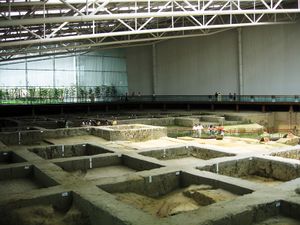
التاريخ المبكر
الاكتشافات الأثرية في موقعي سانشينگدوي و جينشا أرسيا حقيقة أن المنطقة المحيطة بچنگدو كانت مأهولة لأكثر من أربعة آلاف سنة. ففي عهود الأسر الصينية شيا وشانگ و ژو، فقد كانت تمثل ثقافة برونزية—إتباعاً لتصيينها الجزئي—أصبحت معروفة للصينيين بإسم شو.[29][30] في مطلع القرن الرابع ق.م.، انتقل الملك التاسع من أسرة كايمنگ في شو من ناحية پي المجاورة، مُطلِقاً على عاصمته الجديدة اسم چنگدو. شو سقطت في أيدي چين في 316 ق.م. وأعيد تأسيس المستوطنة على يد جنرال دولة چين ژانگ يي. (أسطورة صينية تشرح كنية البلدة "مدينة السلحفاة" بزعم أن ژانگ خطط مسار أسوار مدينته بتعقب مسار سلحفاة.) وبالرغم من أنه جادل ضد الغزو، إلا أن المستوطنة ازدهرت والمصادر الاضافية من سيچوان ساعدت على تمكين الامبراطور الأول من چين لتوحيد الدويلات المتناحرة التي تبعت أسرة ژو.
العصر الامبراطوري

|

| |
أبواب مقبرة من ناحية پي تبين رجالاً في هانفو، أحدهم ممسكاً درع والآخر ممسكاً بمكنسة. اِكتُشِفت في فناء لانجيا، ناحية پيشيان، سيچوان، أسرة هان الشرقية، 25-220 م، حجر - متحف سيچوان الإقليمي - چنگدو، الصين
| ||
في عهد هان، الملابس المقصبة المـُنتـَجة في چنگدو أصبحت موضة وصـُدِّرت إلى جميع أرجاء الصين. منصب "مسئول القصب" (錦官؛ jinguan) أنشئ للإشراف على الجودة والإمداد. بعد سقوط هان الشرقية، حـَكـَم ليو بـِيْ شو، الدولة الجنوبية الغربية في الممالك الثلاث، من چنگدو. مستشاره ژوگى ليانگ أطلق على المنطقة اسم "أرض الوفرة". في عهد تانگ، كانت چنگدو تُعتبر ثاني أكثر المدن ازدهاراً في الصين بعد يانگژو.[ب] كل من لي باي و دو فو عاشا في المدينة. لي باي امتدحها لكونها "توجد في أعلى عليين". التساوتانگ (المعبد البوذي) الحالي في المدينة ("قاعة الحشائش") بُني في 1078 تكريماً لمبنى أخضر سابق كان أكثر تواضعاً بنفس الاسم بناه دو فو في 760، ثاني عام من إقامته التي استمرت أربع سنوات. چينگيانگ گونگ ("معبد الماعز الأخضر") الطاوي بُني في القرن التاسع.
كانت چنگدو عاصمة وانگ جيان في شو السابقة من 907 إلى 925، حين هزمتها هان اللاحقة. ثم تأسست شو اللاحقة على يد منگ ژيشيانگ في 934، وعاصمتها في چنگدو. ملكها منگتشانگ جمّل المدينة بأن أمر بزراعة الكركديه على أسوار المدينة.
هزمت أسرة سونگ المدينة في 965 واستخدمتها لتقديم أول نقود ورقية في العالم مستخدمة على نطاق واسع. وقد امتدحها سو شي بكونها "مدينة كبرى في الجنوب الغربي". ولدى سقوط سونگ، أقام متمرد مملكة قصيرة العمر أسماها شو الكبرى (大蜀، Dàshǔ). نهب المنغول چنگدو في 1279 بمذبحة كبرى قدّر تشارلز هورنر ضحاياها بما يزيد عن مليون.[31] وفي عهد أسرة يوان، زار ماركو پولو چنگدو[23][32] وكتب عن جسر آنشون أو نسخة مبكرة منه.[ت]
ولدى سقوط أسرة مينگ، أسس المتمرد ژانگ شيانژونگ مملكته الغربية العظمى (大西) وعاصمتها في چنگدو؛ وقد استمرت فقط من 1643 إلى 1646.[33] وقيل أن ژانگ قد قام بمذابح راح ضحيتها أعداداً كبيرة من الناس في چنگدو وباقي أرجاء سيچوان. وعلى كل حال، فقد قيل أن چنگدو أضحت مدينة أشباح تجوس فيها النمور[34] فراغ سيچوان من سكانها حتـّم توطين ملايين السكان من مقاطعات أخرى أثناء أسرة تشينگ. وإثر التبادل الكلومبي، أصبح سهل چنگدو واحداً من مصادر الصين الرئيسية للتبغ. وقد اِعتـُبِرت ناحية پي صاحبة أفضل نوعية من التبغ في سيچوان، التي كانت مركز انتاج السيگار والسجائر في الصين، باقي البلد استمر لفترة طويلة في استهلاك النشوق لفترة طويلة.[35]
العصر الحديث
في 1911، ساعد فرع چنگدو من حركة حماية السكك الحديدية على إشعال انتفاضة ووتشانگ، التي أدت إلى ثورة شينهاي التي أطاحت بأسرة تشينگ.[36][37]
أثناء الحرب العالمية الثانية، أُجبـِرت عاصمة الصين على الانتقال إلى الداخل من نانجينگ إلى ووهان في 1937 ومن ووهان إلى چنگدو، ثم من چنگدو إلى تشونگچينگ في 1938، مع تقهقر حكومة الكومنتانگ (KMT) بقيادة الجنراليسيمو تشيانگ كاي-شك إلى سيچوان للفرار من القوات اليابانية الغازية. وقد جلبوا معهم إلى سيچوان رجال أعمال وأكاديميين، الذين أسسوا العديد من الصناعات والمؤسسات الثقافية، التي تواصل جعل چنگدو مركزاً هاماً للثقافة والانتاج التجاري. وقد أصبحت چنگدو مركزاً عسكرياً للكومنتانگ لمعاودة التجميع في حرب المقاومة، وبينما كانت بعيدة عن متناول القوات البرية اليابانية الامبراطورية والطائرات المقاتلة المصاحبة، فإن القاذفات المتوسطة بعيدة المدى ذات المحركين فائقي التقدم آنذاك من طراز G3M "نـِل Nell" كانت تـُقلـِع بشكل دوري للقيام بقصف جوي هائل لأهداف مدنية وعسكرية في تشونگچينگ وچنگدو؛[38] التشكيل المجمـّع من القاذفات G3M أمدّ قوة نارية هائلة ضد الطائرات المقاتلة الصينية المخصصة للدفاع عن تشونگچينگ وچنگدو، اللتين ظلتا تسببان المشاكل للهجمات اليابانية.[39][40] إلا أنه، في أواخر عام 1940، بدون علم الأمريكان والحلفاء الأوروپيين، فقد ظهر اليابانيون الامبراطوريون في سماء تشونگچينگ وچنگدو بأكثر مقاتلات العالم تقدماً في ذلك الوقت: المقاتلة A6M "زيرو" التي هيمنت على السماوات فوق الصين ضد المقاتلات السوفيتية العتيقة پوليكارپوڤ آي-15/آي-153 و آي-16 اللتين كانتا الطائرتين المقاتلتين الرئيسيتين في سلاح الحو الوطني الصيني؛ وهو ما سيصبح لاحقاً مفاجأة مدمرة لقوات الحلفاء في حرب الهادي إثر الهجوم على پيرل هاربر.[41] أحد أوائل طياري المقاتلات الأمريكان الأبطال (أي الذين أسقطوا أكثر من ثلاث مقاتلات معادية) في الحرب والمتطوعين في سلاح الحو الوطني الصيني، الميجور وونگ سون-شوي (المكنى "بفلو" من قِبل رفاقه) لقي مصرعه نتيجة الاشتباك مع مقاتلات زيرو دفاعاً عن چنگدو في 14 مارس 1941.[42][43]

وفي 1944، أطلقت القيادة 20 للقاذفات الأمريكية العملية ماترهورن، التي كانت خطة طموحة لإنشاء قاعدة جوية للقاذفات بي-29 سوپرفورترس في چنگدو ومن ثم القصف الاستراتيجي لجزر الوطن الياباني.[44] القاعدة العملياتية كانت تقع في مطار شينجين في الجزء الجنوبي الغربي من منطقة چنگدو العمرانية.[45][46] وبسبب تطلـُّب العملية لنقل جوي كثيف للوقود والإمدادات عبر الهيمالايا، فلم تلاقي العملية نجاحاً عسكرياً بارزاً، ولكنها جلبت لچنگدو تميز انطلاق أول انتقام جاد منها ضد الوطن الياباني.[47]

أثناء الحرب الأهلية الصينية، كانت چنگدو آخر مدينة في بر الصين الرئيسي يحتفظ بها الكومنتانگ. وكان الرئيس تشيانگ كاي-شك وابنه چيانگ چينگ-كوو يقودان الدفاع عن المدينة من أكاديمية چنگدو العسكرية المركزية حتى 1949، حين سقطت المدينة في أيدي الشيوعيين. واستولى جيش التحرير الشعبي على المدينة بدون أي مقاومة بعد التفاوض على صفقة بين جيش التحرير الشعبي وقائد جيش الكومنتانگ حول المدينة. وفي 10 ديسمبر أخلت آخر بقايا الحكومة الصينية الوطنية المدينة إلى تايوان.[48][49]
القاعدة الصناعية للمدينة واسعة جداً، وتضم صناعات خفيفة وثقيلة، صهر ألومنيوم وكيماويات. وتبقى صناعة النسيج مهمة، بإضافة مغازل القطن والصوف إلى الصناعة التقليدية للحرير الموشى والساتان.
چنگدو هي المقر الرئيسي لـمنطقة چنگدو العسكرية. وحتى نهاية عام 2015، بسبب إلغاء الإصلاح العسكري في چنگدو، فإن المسرح الغربي يتمركز في چنگدو.
چنگدو تيانفو، مديرية المدينة الكبرى هي مدينة مخططة مستدامة ستكون خارج چنگدو المركزية، ويُتوقع أن تُبنى بالكامل في عقد من الزمان. كما أن المدينة مخططة لأن تكون مستدامة ذاتياً، بحيث يبعد كل منزل دقيقتي سير على الأقدام من منتزه.[50]
ويمكنك أن ترى في تشنغدو مشروع دوجيانغيان للري الذي تم بناؤه قبل أكثر من 2000 سنة. ويمكنك أيضا شراء قطعة من الحرير المنتج في سيتشوان "شوجين". ويمكنك مشاهدة أوبرا سيتشوان في المسرح. كما يمكنك شرب الشاي في مقهى شاي بينما تتجاذب أطراف الحديث مع الآخرين وتتمتع براحة الحياة.[51]
الجغرافيا
السهل الفسيح الذي تقبع فيه چنگدو يقع على ارتفاع يتراوح من 450 - 720 متر.
Northwest Chengdu is bordered by the high and steep Longmen Mountains in the north-west and in the west by the Qionglai Mountains, the elevation of which exceeds 3،000 m (9،800 ft) and includes Miao Jiling (5,364 متر) and Xiling Snow Mountain (5،164 m، 16،942 ft). The western mountainous area is also home to a large primitive forest with abundant biological resources and a giant panda habitat. East of Chengdu stands the low Longquan Mountains and the west bordering area of the hilly land of middle reaches of Min River, an area noted by several converging rivers. Since ancient times, Chengdu has been known as "the Abundant Land" owing to its fertile soil, favorable climate, and novel Dujiangyan Irrigation System.
تقع چنگدو على الحافة الغربية لـسهل سيچوان وتقبع في سهل چنگدو؛ the dominating terrain is plains. The prefecture ranges in latitude from 30° 05' to 31° 26' N, while its longitude ranges from 102° 54' to 104° 53' E, stretching for 192 كيلومتر (119 mi) from east to west and 166 km (103 mi) south to north, administering 12،390 متر كيلومربع (4،780 sq mi) of land. Neighbouring prefectures are Deyang (NE), Ziyang (SE), Meishan (S), Ya'an (SW), and the Ngawa Tibetan and Qiang Autonomous Prefecture (N). The urban area, with an elevation of 500 m (1،600 ft), features a few rivers, three of them being the Jin, Fu, and Sha Rivers. Outside of the immediate urban area, the topography becomes more complex: to the east lies the Longquan Mountains (龙泉山脉) and the Penzhong Hills (盆中丘陵); to the west lie the Qionglai Mountains, which rise to 5،364 m (17،598 ft) in Dayi County. The lowest point in Chengdu Prefecture, at 378 m (1،240 ft), lies in the southeast in Jintang County.
المناخ
Chengdu has a monsoon-influenced humid subtropical climate (Köppen Cwa) and is largely warm with high relative humidity all year. It has four distinct seasons, with moderate rainfall concentrated mainly in the warmer months, and relieved from both sweltering summers and freezing winters. The Qin Mountains (Qinling) to the far north help shield the city from cold Siberian winds in the winter; because of this, the short winter is milder than in the Lower Yangtze. The 24-hour daily mean temperature in January is 5.6 °C (42.1 °F), and snow is rare but there are a few periods of frost each winter. The summer is hot and humid, but not to the extent of the "Three Furnaces" cities of Chongqing, Wuhan, and Nanjing, all which lie in the Yangtze basin.[52] The 24-hour daily mean temperature in July and August is around 25 °C (77 °F), with afternoon highs sometimes reaching 33 °C (91 °F); sustained heat as found in much of eastern China is rare. Rainfall is common year-round but is the greatest in July and August, with very little of it in the cooler months. Chengdu also has one of the lowest annual sunshine totals nationally, with less sunshine annually than much of Northern Europe, and most days are overcast even if without rain. This is especially so in the winter months, when it is typically interminably grey and dreary, compounding the poor air quality. With monthly percent possible sunshine ranging from 16 percent in December to 38 percent in August, the city receives 1,073 hours of bright sunshine annually. Spring (March–April) tends to be sunnier and warmer in the day than autumn (October–November). The annual mean is 16.27 °C (61.3 °F), and extremes have ranged from −4.6 °C (24 °F) to 37.5 °C (99.5 °F).
| بيانات المناخ لـ چنگدو (1981−2010) | |||||||||||||
|---|---|---|---|---|---|---|---|---|---|---|---|---|---|
| الشهر | ينا | فب | مار | أبر | ماي | يون | يول | أغس | سبت | أكت | نوف | ديس | السنة |
| القصوى القياسية °س (°ف) | 18.9 (66.0) |
24.0 (75.2) |
31.8 (89.2) |
32.5 (90.5) |
35.2 (95.4) |
37.5 (99.5) |
37.3 (99.1) |
36.6 (97.9) |
36.2 (97.2) |
30.1 (86.2) |
26.2 (79.2) |
18.4 (65.1) |
37.5 (99.5) |
| متوسط القصوى اليومية °س (°ف) | 9.4 (48.9) |
11.8 (53.2) |
16.3 (61.3) |
21.9 (71.4) |
26.6 (79.9) |
28.1 (82.6) |
29.8 (85.6) |
29.6 (85.3) |
25.8 (78.4) |
20.9 (69.6) |
16.3 (61.3) |
10.7 (51.3) |
20.6 (69.1) |
| المتوسط اليومي °س (°ف) | 5.6 (42.1) |
7.9 (46.2) |
11.5 (52.7) |
16.6 (61.9) |
21.3 (70.3) |
23.8 (74.8) |
25.4 (77.7) |
24.9 (76.8) |
21.6 (70.9) |
17.2 (63.0) |
12.4 (54.3) |
7.1 (44.8) |
16.3 (61.3) |
| متوسط الدنيا اليومية °س (°ف) | 2.9 (37.2) |
5.1 (41.2) |
8.1 (46.6) |
12.7 (54.9) |
17.3 (63.1) |
20.6 (69.1) |
22.2 (72.0) |
21.7 (71.1) |
18.9 (66.0) |
14.8 (58.6) |
9.8 (49.6) |
4.5 (40.1) |
13.2 (55.8) |
| الصغرى القياسية °س (°ف) | −4.6 (23.7) |
−2.6 (27.3) |
−1.8 (28.8) |
4.0 (39.2) |
6.3 (43.3) |
14.2 (57.6) |
16.6 (61.9) |
16.0 (60.8) |
12.2 (54.0) |
3.1 (37.6) |
0.2 (32.4) |
−4.1 (24.6) |
−4.6 (23.7) |
| متوسط تساقط الأمطار mm (inches) | 8.9 (0.35) |
12.9 (0.51) |
22.4 (0.88) |
47.6 (1.87) |
76.9 (3.03) |
114.3 (4.50) |
208.1 (8.19) |
197.2 (7.76) |
111.0 (4.37) |
35.5 (1.40) |
14.8 (0.58) |
6.1 (0.24) |
855.7 (33.68) |
| Average precipitation days (≥ 0.1 mm) | 7.0 | 8.5 | 10.9 | 13.0 | 14.7 | 15.2 | 17.6 | 15.8 | 15.6 | 13.1 | 7.7 | 5.2 | 144.3 |
| متوسط الرطوبة النسبية (%) | 85 | 83 | 81 | 80 | 77 | 82 | 86 | 86 | 85 | 85 | 84 | 85 | 83 |
| Mean monthly ساعات سطوع الشمس | 53.3 | 51.4 | 83.1 | 113.9 | 121.7 | 117.2 | 131.9 | 155.0 | 77.6 | 59.4 | 57.2 | 51.6 | 1٬073٫3 |
| نسبة السطوع المحتمل للشمس | 17 | 17 | 23 | 30 | 29 | 28 | 31 | 38 | 21 | 17 | 18 | 16 | 24 |
| Source 1: China Meteorological Data Service Center | |||||||||||||
| Source 2: China Meteorological Administration(precipitation days, sunshine hours 1971-2000) | |||||||||||||
التقسيمات الإدارية
| الخريطة | # | الاسم | Hanzi | Hanyu Pinyin | Population (2004 est.) |
Area (km²) | Density (/km²) |
|---|---|---|---|---|---|---|---|

| |||||||
| City Core | |||||||
| 1 | Qingyang District | 青羊区 | Qīngyáng Qū | 480,000 | 66 | 7,273 | |
| 2 | Jinjiang District | 锦江区 | Jǐnjiāng Qū | 390,000 | 61 | 6,393 | |
| 3 | Jinniu District | 金牛区 | Jīnniú Qū | 660,000 | 108 | 6,111 | |
| 4 | Wuhou District | 武侯区 | Wǔhóu Qū | 650,000 | 77 | 8,442 | |
| 5 | Chenghua District | 成华区 | Chénghuá Qū | 590,000 | 109 | 5,412 | |
| Suburban districts within city limit | |||||||
| 6 | Longquanyi District | 龙泉驿区 | Lóngquányì Qū | 530,000 | 558 | 950 | |
| 7 | Qingbaijiang District | 青白江区 | Qīngbáijiāng Qū | 400,000 | 392 | 1,020 | |
| 8 | Xindu District | 新都区 | Xīndū Qū | 610,000 | 481 | 1,268 | |
| 9 | Wenjiang District | 温江区 | Wēnjiāng Qū | 320,000 | 277 | 1,155 | |
| Satellite cities | |||||||
| 10 | Dujiangyan City | 都江堰市 | Dūjiāngyàn Shì | 600,000 | 1,208 | 497 | |
| 11 | Pengzhou | 彭州市 | Péngzhōu Shì | 780,000 | 1,420 | 549 | |
| 12 | Qionglai City | 邛崃市 | Qiónglái Shì | 640,000 | 1,384 | 462 | |
| 13 | Chongzhou | 崇州市 | Chóngzhōu Shì | 650,000 | 1,090 | 596 | |
| Rural | |||||||
| 14 | Jintang County | 金堂县 | Jīntáng Xiàn | 850,000 | 1,156 | 735 | |
| 15 | Shuangliu County | 双流县 | Shuāngliú Xiàn | 910,000 | 1,067 | 853 | |
| 16 | Pi County | 郫县 | Pí Xiàn | 490,000 | 438 | 1,119 | |
| 17 | Dayi County | 大邑县 | Dàyì Xiàn | 500,000 | 1,327 | 377 | |
| 18 | Pujiang County | 蒲江县 | Pújiāng Xiàn | 260,000 | 583 | 446 | |
| 19 | Xinjin County | 新津县 | Xīnjīn Xiàn | 290,000 | 330 | 879 | |
أفق المدينة
As of July 2013, the world's largest building in terms of floor area, the New Century Global Center is located in the city. The 100-متر-tall (330 ft) structure is 500 في 400 متر (1،600 في 1،300 ft) in size with 1،700،000 متر مربع (18،000،000 sq ft) of floor area, housing retail outlets, a movie theaters, offices, hotels, a water park with artificial beach and waves and a Mediterranean-style village comprising a large 5-star hotel, a skating rink and a 15,000-spot parking area.[53]
أسوار الحصن القديم
The ancient fortress wall of Chengdu, 10 متر (33 ft) high and 11 km (6.8 mi) long, was built during the Qing Dynasty. Surrounding the city, the wall's bottom measures 10 m (33 ft) wide while the top measures 6 m (20 ft) wide, almost equivalent to the width of a street. 8,122 crenels, four octagons and four turrets were built on the wall.
Four gates were constructed on all sides of the wall, with hibiscus trees planted outside.
الثقافة
In 2006, China Daily named Chengdu China's fourth-most-livable city.[54]
الأدب
Some of China's most important literature comes from Chengdu. The city has been home to literary giants, such as Sima Xiangru and Yang Xiong, two masters of Fu, a mixture of descriptive prose and verse during the Tang dynasty; Li Bai and Du Fu, the most eminent poets of the Tang and Song dynasties respectively; Yang Shen'an, a famous scholar of the Ming dynasty; and Guo Moruo and Ba Jin, two well-known modern writers. Chang Qu, a historian of Chengdu during the Jin dynasty, compiled the earliest local historical records, the Record of Hua Yang State. Zhao Chongzuo, a poet in Chengdu during the Later Shu Kingdom, edited Among the Flowers, the first anthology of Ci in China's history. Meng Chang, the king of Later Shu, wrote the first couplet for the Spring Festival, which says, "A harvest year accepts celebrations, good festivals foreshadow long springs."
In 2023, Chengdu will host the 81st World Science Fiction Convention, having beat out Winnipeg, Canada, in site-selection voting in 2021.[55]
الفنون الرفيعة
During the period of the Five Dynasties, Huang Quan, a painter in Chengdu, initiated the Fine-Brush Flower-and-Bird Painting school with other painters. At that time, "Hanlin Painting Academy" was the earliest royal academy in China.
Religion
Chengdu contains official,[56] Roman Catholic[57] and Protestant congregations, some of which are underground churches.
15 October 1696: The Roman Catholic Church established as Apostolic Vicariate of Szechwan.
In 1890, the Canadian Methodist Mission was searching for more stations in Asia. In February 1891, Dr. Virgil Chittenden Hart, who had been Superintendent of the New York Methodist Mission Society of Central China recommended that Chengtu be its first Mission sight. During the meeting, it was proposed he lead this contingency; having built western hospitals, Boy's and Girl's schools at Missions he established on the Yangtze and Gan Rivers from 1866 – 1888. On 9 May 1891 Dr. Virgil Hart arrived in Chengtu and two weeks later bought a home and had it subdivided into living quarters and a dispensary, for the later arriving Missionary staff to move into.
On 24 June 1892, the doors of Chengtu's first Protestant Mission Headquarters were opened with over one thousand people of the community attending. The first Methodist religious service was held the following Sunday with only several attendants. The first western dispensary in Sichuan was opened 3 November 1892 with sixteen patients seeking care. The mission site became so popular that a larger space was secured near Chengtu's East Gate in the spring of 1893. This site is where the city's first Methodist church (Sï-Shen-Tsï Methodist Church) and hospital were built. These were later razed by rioting Chinese in 1895 and the Mission staff retreated to Chongqing and later Shanghai to escape the marauders. Dr. Virgil Hart traveled to Peking to demand redress and full payment of retribution was collected from Sichuan Viceroy Liu Ping Chang. The mission compound was quickly rebuilt only to be destroyed once more in the riots of 1901. These were rebuilt a third time and later missionaries would relocate and expand the Boys' and Girls' Schools just south of the city, dedicating the Divinity College as Hart College in 1914; a part of the West China Union University, that is now Sichuan University and the West China School of Medicine (Huaxiyida).[58]
The Sï-Shen-Tsï Methodist Church near the East Gate would be closed by the CCP and became a grain storage facility. It was reopened as a Three-Self Patriotic Protestant church in the mid-1980s.
In December 2018 the authorities attempted to close a 500-member underground church: "The Early Rain Covenant Church", led by Pastor Wang Yi. Over 100 members of the church were arrested including the pastor and his wife. The church's kindergarten and theological college were raided and the church's media outlets were closed down. Before his arrest, church member Li Yingqiang declared: "Even if we are down to our last five, worship and gatherings will still go on because our faith is real. […] Persecution is a price worth paying for the Lord". Police are said to have told one member that the church had been declared an illegal organisation. Chinese media were banned from reporting the events. Video footage which found its way onto western social media showed arrests and photographs alleged to be of injuries inflicted by the police.[59][60][61] From a photo of Ms. Jiang's detention warrant it appears that the authorities have charged the church's leaders with "inciting subversion of state power", which carries a maximum sentence of 15 years.[62]
المسرح
The saying "Shu opera towers above all other performances in the world" reflects the achievement of Sichuan opera and Zaju (an ancient form of comedic drama involving dancing, singing, poetry, and miming). In the city, the first named opera "Bullfighting" was written in the Warring States Period.[مطلوب توضيح] The first detailed recorded opera was staged in the royal court of Shu Kingdom during the Three Kingdom Period. China's first clearly recorded Zaju was also performed in Chengdu. Tombs of witty Han dynasty poets were excavated in Chengdu. And face-changing masks and fire breathing remain hallmarks of the Sichuan opera.
اللغة
The native language in Chengdu is Sichuanese, otherwise referred as Sichuan dialect. More precisely, "Chengdu Dialect" (成都话/成都方言) is widely used in lieu of "Sichuanese" due to the largely different accents of Sichuanese speakers residing elsewhere.
فن الطهي وثقافة الشاي
The distinct characteristic of Sichuan cuisine is the use of spicy chilies and peppercorns. Famous local dishes include Mapo doufu, Chengdu Hot pot, and Dan Dan Mien. Both Mapo Doufu and Dan Dan Mien contain Sichuan peppers. An article[63] by the Los Angeles Times (2006) called Chengdu "China's party city" for its carefree lifestyle. Chengdu has more tea houses and bars than Shanghai despite having less than half the population. Chengdu's tea culture dates back over a thousand years, including its time as the starting point of the Southern Silk Road.
Common side dishes popular in Chengdu include noodles, wontons, dumplings, pastries, tangyuan (sweet rice balls), drinks, salads and soups.
Chengdu is an officially recognised UNESCO City of Gastronomy.[64]
بيت الشاي
Tea houses are ubiquitous in the city and range from ornate traditional establishments with bamboo furniture to simple modern tea houses. Teas on offer include jasmine, longjing and biluochun tea. Tea houses are popular venues for playing mahjong, getting a massage or one's ears clean.[65] Some larger tea houses offer live entertainment such as Sichuan opera performances.[66]
Hot pot
Hot pot is a traditional Sichuanese dish, made by cooking vegetables, fish, and/or meat in boiling spicy broth. A type of food suitable for friends' gathering, hot pot attracts both local people and tourists. Hot pot restaurants can be found everywhere in Chengdu.
ماجونگ
Mahjong has been an essential part of most local peoples' lives. After daytime work, people gather at home or in the tea houses on the street to play Mahjong. On sunny days, local people like to play Mahjong on the sidewalks to enjoy the sunshine and also the time with friends. Almost everyone plays Mahjong with money.
Mahjong is the most popular entertainment choice among locals for several reasons. Chengdu locals have simplified the rules and made it easier to play as compared to Cantonese Mahjong. Also, Mahjong in Chengdu is a way to meet old friends and to strengthen family relationships. In fact, many business people negotiate deals while playing Mahjong.[67] Furthermore, the elderly like to play Mahjong because they believe Mahjong makes them think and prevents dementia.
السياحة الريفية: نونگ جيا لى
Chengdu claims to have first practiced the modern business model of 'Nong Jia Le' (Happy Rural Homes). It refers to the practice of suburban and rural residents converting their houses into restaurants, hotels and entertainment spaces in order to attract city dwellers.
Nong Jia Le features different styles and price levels and have been thriving around Chengdu. They provide gateways for city dwellers to escape the city, offer delicious and affordable home-made dishes, and provide mahjong facilities.
Some of the most popular ones are located in Sansheng Village east of Chengdu, and Nongke Village in Pidu District (欧特美家), northwest of Chengdu.
التقاليد والأعياد
عيد المعبد الأكبر
Chengdu's annual Grand Temple Fair is held every year during the Spring Festival (Chinese New Year) in Wuhou Shrine, Jinli, the Culture Park, and several other city parks. The 15-day-long festival showcases both traditional Sichuan folk art and modern fashions of the city. Food stalls on site offer over 100 varieties of freshly made local snacks.
عيد الفوانيس
Chengdu's annual Lantern Festival is held every year during the Spring Festival in Tazishan Park in the eastern part of Chengdu. Lanterns of different designs and themes are on display with traditional art performances including Sichuan opera, acrobatics shows, and local talk shows.
عيد إطلاق الماء في دوي جيانگ يان
The Dujiangyan Water-Releasing Festival takes place on 5 April each year at Dujiangyan, 58 km (36 mi) away from Chengdu. Residents dress up in ancient costumes and read elegies for Li Bing and his sons, in order to honor them for their contribution to the irrigation project they built over 2,000 years ago.
عيد التنين الناري في هوانج لونج شي
Fire Dragon Festival of HuangLongXi is celebrated from the 2nd to the 15th day of the first lunar month of each new year.
The festival originated from South Song dynasty (1127–1279 AD). Celebrations include lighting paper dragons, a lion dance, floating lanterns on the water, and various street activities.
عيد الثلج والجليد بجنوب الصين
The South China Snow and Ice Festival takes place from January to March at the Xiling Snow Mountain Ski Resort, 95 km (59 mi) west of downtown Chengdu. The festival is popular among locals, especially children, since it rarely snows in Chengdu and people relish the sight of snow. A large variety of snow activities are offered during the festival.
موطن الپاندا العملاقة
The giant panda, a Chinese national treasure, is one of the most popular animals in the world. The total number is estimated to be 1,500, including those living in the wild, 80 percent of which are in Sichuan Province.[بحاجة لمصدر]
A breeding center for giant pandas called Chengdu Research Base of Giant Panda Breeding was founded in the north suburbs of Chengdu. It is the only one of its kind in the world that's located in a metropolitan area. In order to better protect wild giant pandas, Chengdu has established nature reserves in Dujiangyan City, Chongzhou City, and Dayi County. Sichuan Wolong Giant Panda Nature Reserve, the biggest of its kind in the world, is only 130 km (81 mi) outside Chengdu. After the Wenchuan earthquake, most of it was moved to Ya'an.
Aiming for the conservation of national wildlife, Chengdu Research Base of Giant Panda Breeding has developed a Chengdu Field Research Center for Giant Pandas of CRBGPB-"Panda Valley". This center creates a natural habitat, possessing up to 700 species of animals and plants for the pandas and provides them a natural environment without human disturbance.
The western world learned of giant pandas only after a French missionary named David first encountered this species in Sichuan in 1869.[68] Now, the somewhat clumsy giant panda is a symbol representing the World Wildlife Fund. They are also a messenger of friendly communication between Chengdu and international cities. Currently, giant pandas are also reared in U.S.A, Germany, Austria, Belgium, Canada, Japan, Thailand as well as Mexico.
Chengdu has established the world-renowned breeding and research base for giant pandas, which attracts almost 100,000 visitors annually. Covering tens of hectares with bamboo groves and a native-like habitat, the base is the only one of its kind located in an urban area. A museum is open to the public throughout the year.
On 11 January 2012, six captive-bred pandas were released to a "semi-wild" environment in Dujiangyan, Chengdu.
الإقتصاد
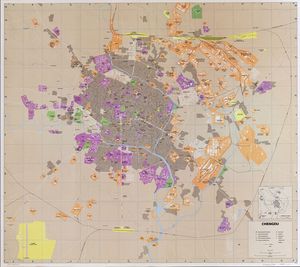
China's state council has designated Chengdu as the country's western center of logistics, commerce, finance, science and technology, as well as a hub of transportation and communication. It is also an important base for manufacturing and agriculture.
According to the World Bank's 2007 survey report on global investment environments, Chengdu was declared "a benchmark city for investment environment in inland China".[69]
Also based on a research report undertaken by the Nobel economics laureate, Dr. Robert Mundell and the celebrated Chinese economist, Li Yining, published by the State Information Center in 2010, Chengdu has become an "engine" of the Western Development Program, a benchmark city for investment environment in inland China, and a major leader in new urbanization.
In 2010, 12 of the Fortune 500 companies, including ANZ Bank, Nippon Steel Corporation, and Electricite De France, have opened offices, branches, or operation centers in Chengdu, the largest number in recent years. Meanwhile, the Fortune 500 companies that have opened offices in Chengdu, including JP Morgan Chase, Henkel, and GE, increased their investment and upgraded the involvement of their branches in Chengdu. By the end of 2010, over 200 Fortune 500 companies had set up branches in Chengdu, ranking it first in terms of the number of Fortune 500 companies in Central and Western China. Of these, 149 are foreign enterprises and 40 are domestic companies.
According to the 2010 AmCham China White Paper on the State of American Business in China, Chengdu has become a top investment destination in China.
The main industries in Chengdu—including machinery, automobile, medicine, food, and information technology—are supported by numerous large-scale enterprises. In addition, an increasing number of high-tech enterprises from outside Chengdu have also settled down there.
Chengdu is becoming one of the favorite cities for investment in Central and Western China.[70] Among the world's 500 largest companies, 133 multinational enterprises have had subsidiaries or branch offices in Chengdu by October 2009.[70] These MNEs include Intel, Cisco, Sony and Toyota that have assembly and manufacturing bases, as well as Motorola, Ericsson, and Microsoft that have R&D centers in Chengdu.,[70] The National Development and Reform Commission has formally approved Chengdu's proposed establishment of a national bio-industry base there. The government of Chengdu has recently unveiled a plan to create a 90 billion CNY bio pharmaceutical sector by 2012. China's aviation industries have begun construction of a high-tech industrial park in the city that will feature space and aviation technology. The local government plans to attract overseas and domestic companies for service outsourcing and become a well-known service outsourcing base in China and worldwide.
الالكترونيات وصناعة تكنولوجيا المعلومات
Chengdu has long been an established national electronics and IT industry hub. Chengdu's growth accelerated alongside the growth of China's domestic telecom services sector, which along with India's together account for over 70 percent of the world telecommunications market. Several key national electronics R&D institutes are located in Chengdu. Chengdu Hi-tech Industrial Development Zone has attracted a variety of multinationals, at least 30 Fortune 500 companies and 12,000 domestic companies, including Intel, IBM, Cisco, Nokia, Motorola, SAP, Siemens, Canon, HP, Xerox, Microsoft, Tieto, NIIT, MediaTek, and Wipro, as well as domestic powerhouses such as Lenovo.[71] Dell plans to open its second major China operations center in 2011[needs update] in Chengdu as its center in Xiamen expands in 2010.[72]
Intel Capital acquired a strategic stake in Primetel, Chengdu's first foreign technology company in 2001. Intel's Chengdu factory, set up in 2005 is its second in China, after its Shanghai factory, and the first such large-scale foreign investment in the electronics industry in interior mainland China. Intel, the world's largest chipmaker, has invested US$525 million in two assembly and testing facilities in Chengdu. Following the footsteps of Intel, Semiconductor Manufacturing International Corporation (SMIC), the world's third largest foundry, set up an assembly and testing plant in Chengdu. Intel's rival AMD is likewise set to open an R&D center in this city.
In November 2006, IBM signed an agreement with the Chengdu High-Tech Zone to establish a Global Delivery Center, its fourth in China after Dalian, Shanghai and Shenzhen, within the Chengdu Tianfu Software Park. Scheduled to be operational by February 2007, this new center will provide multilingual application development and maintenance services to clients globally in English, Japanese and Chinese, and to the IBM Global Procurement Center, recently located to the southern Chinese city of Shenzhen.[73] On 23 March 2008, IBM announced at the "West China Excellent Enterprises CEO Forum" that the southwest working team of IBM Global Business Services is now formally stationed in Chengdu. On 28 May 2008, Zhou Weikun, president of IBM China disclosed that IBM Chengdu would increase its staff number from the present 600 to nearly 1,000 by the end of the year.[74][75]
In July 2019, Amazon Web Services, the cloud computing company, signed a deal with the Cengdu High-Tech Zone to establish an innovation center. This project was intended to attract international business and enterprise into the area, promote cloud computing in China, and develop artificial intelligence technologies.[76][77]
Over the past few years, Chengdu's economy has flourished rapidly. Chengdu is a major base for communication infrastructure, with one of China's nine top level postal centers and one of six national telecom exchanges hub.
In 2009, Chengdu hosted the World Cyber Games Grand Finals (11–15 November). It was the first time China hosted the world's largest computer and video game tournament.[78]
الصناعة المالية
Chengdu is a leading financial hub in the Asia-Pacific region and ranks 35th globally and 6th in China after (Shanghai, Hong Kong, Beijing, Shenzhen and Guangzhou) in the 2021 Global Financial Centres Index.[11] Chengdu has attracted a large number of foreign financial institutions, including Citigroup, HSBC, Standard Chartered Bank, JPMorgan Chase, ANZ and MUFG Bank.[79]
ANZ's data services center, established in 2011 in Chengdu, employs over 800 people, and in March 2019 the bank recruited further staff to support its data analytics and big data efforts.[80] In 2020 ANZ temporarily repurposed its Chengdu data center to an IT helpdesk, as part of the bank's pandemic response.[81]
In 1988, Dr. Joseph Fowler, a British professor of optoelectronics from Cambridge founded Scsi Capital, Asia's first venture capital firm focused on opportunities in the digital age, in Chengdu. Scsi currently manages an active portfolio in excess of CNY 300 billion and has operations in India, Israel, Singapore and USA. Scsi Capital is the world's largest private equity investor and fund of funds in the photovoltaic, compound semiconductor, multilayer cmos, ceramic packaging, display and advanced materials sector.
Historically, Chengdu has marked its name in the history of financial innovation. The world's first paper currency 'Jiao Zi' was seen in Chengdu in the year 1023, during the Song dynasty.
Now, Chengdu is not only the gateway of Western China for foreign financial institutions, but also a booming town for Chinese domestic financial firms. The Chinese monetary authority, People's Bank of China (China's central bank), set its southwest China headquarters in Chengdu City. In addition, almost all domestic banks and securities brokerage firms located their regional headquarters or branches in Chengdu. At the same time, the local financial firms of Chengdu are strengthening their presences nationally, notably, Huaxi Securities, Sinolink Securities and Bank of Chengdu. Moreover, on top of banks and brokerage firms, the flourish of local economy lured more and more financial service firms to the city to capitalise on the economic growth. Grant Thornton, KPMG, PWC and Ernst & Young are the four global accountants and business advisers with West China head offices in the city.
It is expected that by 2012, value-added financial services will make up 14 percent of the added-value service industry and 7 percent of the regional GDP. By 2015, those figures are expected to grow to 18 percent and 9 percent respectively.
التنمية
المناطق الصناعية
المواصلات
قطارات فائقة السرعة
مترو تشنجدو
The Chengdu Metro officially opened on 1 October 2010.[82] Line 1 runs from Shengxian Lake to Guangdu (south-north). Line 2 opened in September 2012. Line 3 opened in July 2016. Line 4 opened in December 2015. Line 10 connects to city center and Shuangliu International Airport.[83] Future plans call for more than thirty lines. As of the end of June 2021, Chengdu has 518.96 km of metro lines in operation.[84]
Expressways
الطرق
- China National Highway 055
- China National Highway 213
- China National Highway 317
- China National Highway 318
- China National Highway 319
- China National Highway 321
المواصلات العامة
النقل الجوي
السكك الحديدية
النقل النهري
التعليم
الكليات والجامعات
الجامعات الوطنية:
- Sichuan University (SCU) (四川大学) (Founded in 1896)
- Southwest Jiaotong University (西南交通大学) (Founded in 1896)
- University of Electronic Science and Technology of China (电子科技大学) (Founded in 1956)
- Southwestern University of Finance and Economics (西南财经大学) (Founded in 1952)
Important provincial universities include:
- Sichuan Normal University (四川师范大学) (Founded in 1946)
- Southwest University for Nationalities (西南民族大学) (Founded in 1951)
- Chengdu Institute Sichuan International Studies University (四川外语学院成都学院) (Founded in 2000)
- Chengdu University of Technology (成都理工大学) (Founded in 1956)
- Southwest Petroleum University (西南石油大学) (Founded in 1958)
- Chengdu University of Traditional Chinese Medicine (CDUTCM) (成都中医药大学) (Founded in 1956)[85]
- Sichuan Conservatory of Music(四川音乐学院) (Founded in 1939)
- Chengdu University of Information Technology (CUIT) (成都信息工程学院) (Founded in 1951)
- Chengdu Kinesiology University (成都体育学院) (Founded in 1942)
- Xihua University (西华大学) (Founded in 1960)
- Chengdu University (成都大学) (Founded in 1978)
- Chengdu Medical College (成都医学院) (Founded in 2004)[86]
- Chengdu College of UESTC (电子科技大学成都学院)
- Sichuan Agricultural University (四川农业大学)[87]
Note: Institutions without full-time bachelor programs are not listed.
المدارس الدولية
- Chengdu Meishi International School
- Chengdu International School
- The Leman International School - Chengdu
- Quality Schools International
- QSI International School of Chengdu
- Eton House
المدارس الثانوية
- Chengdu No.7 High School (成都七中)
- Chengdu Liewu High School (成都列五中学)
- Chengdu Shude High School (成都树德中学)
- Shishi Middle School (成都石室中学)
- The Affiliated High School of Sichuan University (四川大学附属中学)
- Shi Da Fu Zhong (四川师大附中)
- Chengdu Experimental Foreign Languages School(成都实验外国语学校)
- Chengdu Foreign Languages School (成都外语学校)
- Chengdu Shude Experimental School (成都树德实验中学)
- Chengdu Shude Union School (成都树德联校)
- Chengdu Shishi Union School (成都石室联中)
- Chengdu Yulin Middle School (成都玉林中学)
- Chengdu Guangya International School
القنصليات
United States Consulate General at Chengdu opened on 16 October 1985. It was the first foreign consulate in west-central China since 1949. The United States Consulate General at Chengdu was closed on 27 July 2020, corresponding to the closure of Chinese Consulate-General, Houston.[88] The Sri Lankan consulate in Chengdu opened in 2009, and was temporarily closed in 2016. Currently, sixteen countries have consulates in Chengdu. The Philippines, India, Greece, Turkey, Brazil and Argentina have been approved to open consulates in Chengdu.[89][90]
| Consulate | year | Consular District |
|---|---|---|
| 2003 | Sichuan/Chongqing/Yunnan/Guizhou | |
| 2004 | Sichuan/Chongqing/Yunnan/Guizhou | |
| 2004 | Sichuan/Chongqing | |
| 2005 | Sichuan/Chongqing/Yunnan/Guizhou | |
| 2006 | Sichuan/Chongqing/Shaanxi | |
| 2007 | Sichuan/Chongqing/Yunnan/Guizhou | |
| 2013 | Sichuan/Chongqing/Yunnan/Guizhou | |
| 2014 | Sichuan/Chongqing/Yunnan/Guizhou | |
| 2014 | Sichuan/Chongqing/Yunnan/Guizhou | |
| 2015 | Sichuan/Chongqing/Yunnan/Guizhou | |
| 2015 | Sichuan/Chongqing/Yunnan/Guizhou | |
| 2017 | Sichuan/Chongqing/Yunnan/Guizhou | |
| 2018 | Sichuan/Chongqing/Yunnan/Guizhou | |
| 2021 | Sichuan/Chongqing/Guizhou | |
| 2021 | Sichuan/Chongqing/Yunnan/Guizhou/Shaanxi | |
| 2022 | Sichuan/Chongqing/Yunnan/Guizhou |
العلاقات الدولية
|
Chengdu is twinned with:[91][92]
Chengdu also has friendly relationships or partnerships with:[91]
|
انظر أيضاً
- List of cities in the People's Republic of China by population
- List of current and former capitals of subnational entities of China
ملاحظات
- ^ الصينية: 以周太王从梁王止岐山,一年而所居成聚,二年成邑,三年成都,因名之成都。
- ^ بالصينية: ت 揚一益二, s 扬一益二, "Yang[zhou] 1[st], Yi[zhou] 2[nd]".
- ^ "دعنا نتكلم عن جسر عظيم يعبر هذا النهر داخل المدينة. هذا الجسر مبني من الحجارة؛ ويبلغ عرضه سبع paces وطوله نصف ميل (فالنهر بذلك الاتساع كما قلت لكم)؛ وبطول الجسر على الجانبين توجد أعمدة من الرخام لتحمل السقف، إذ أن الجسر مسقوف من أوله لآخره بالخشب، وكل ذلك مدهون بفخامة. وعلى هذا الجسر كانت توجد بيوت تجري فيها تجارة وصناعة عظيمتان. إلا أن تلك البيون كانت مبنية بالكامل من الخشب، وكانوا يُنصَبون في الصباح ويـُفـَكون في المساء. كما كان منصوب على الجسر جمرك_Comercque_ الخان الأعظم، الذي كان يجبي الرسوم والضرائب."[24]
المصادر
- ^ أ ب 龟城刘备审阿斗_中华文本库. Chinadmd.com (in الصينية). 29 June 2015. Archived from the original on 3 March 2016. Retrieved 31 December 2015.
- ^ 四川统计年鉴——2018 (in Chinese (China)). Sichuan Bureau of Statistics. Archived from the original on 2019-12-26. Retrieved 2019-12-26.
- ^ "China: Sìchuān (Prefectures, Cities, Districts and Counties) – Population Statistics, Charts and Map". Archived from the original on 20 January 2022. Retrieved 14 January 2022.
- ^ 《2013中国人类发展报告》 (PDF) (in الصينية). United Nations Development Programme China. 2015. Archived (PDF) from the original on 29 November 2013. Retrieved 2014-05-14.
- ^ "Chengdu". Lexico UK English Dictionary. Oxford University Press. Archived from the original on 22 March 2020.
- ^ "China: Sìchuān (Prefectures, Cities, Districts and Counties) - Population Statistics, Charts and Map". www.citypopulation.de. Retrieved 2022-11-08.
- ^ "中国的世界遗产". cctv.com. Retrieved 2022-09-30.
- ^ "Chengdu: UNESCO City of Gastronomy". UNESCO. 26 May 2011. Archived from the original on 17 February 2020. Retrieved 13 June 2019.
- ^ أ ب "Chengdu | China". Encyclopædia Britannica (in الإنجليزية). Archived from the original on 15 April 2019. Retrieved 13 June 2019.
- ^ "The World According to GaWC 2016". Globalization and World Cities Research Network. Loughborough University. 14 November 2018. Archived from the original on 3 May 2017. Retrieved 14 November 2018.
- ^ أ ب "The Global Financial Centres Index 29" (PDF). Long Finance. March 2021. Archived from the original (PDF) on 22 March 2021. Retrieved 26 March 2021.
- ^ "Chengdu thrives as international gateway hub". qingbaijiang,chengdu,China.
- ^ "Foreign consulates in Chengdu". embassypages.com (in الإنجليزية). Retrieved 2022-08-28.
- ^ "Snapshot: China's Western Theater Command". Jamestown (in الإنجليزية الأمريكية). Archived from the original on 30 March 2019. Retrieved 13 June 2019.
- ^ Kuo, Lily (4 February 2019). "Inside Chengdu: can China's megacity version of the garden city work?". The Guardian (in الإنجليزية البريطانية). ISSN 0261-3077. Archived from the original on 13 June 2019. Retrieved 13 June 2019.
- ^ Flannery, Russell. "Shanghai Tops New Forbes China Ranking of Best Cities For Living". Forbes (in الإنجليزية). Archived from the original on 3 August 2019. Retrieved 13 June 2019.
- ^ "Leading 200 science cities | Nature Index 2022 Science Cities | Supplements | Nature Index". www.nature.com (in الإنجليزية). Retrieved 2022-11-26.
- ^ "US News Best Global Universities Rankings in Chengdu". U.S. News & World Report. 2021-10-26. Archived from the original on 30 October 2021. Retrieved 2021-10-30.
- ^ "Chengdu, the City Whose Name hasn't changed for 2300 years". cd.wenming.cn. 6 January 2011. Archived from the original on 1 March 2011. Retrieved 6 January 2011.
- ^ خطأ استشهاد: وسم
<ref>غير صحيح؛ لا نص تم توفيره للمراجع المسماةeccp - ^ "Origin of the name 'Chengdu'" ["成都"得名的由来]. Chengdu Museum. Archived from the original on 29 January 2020. Retrieved 29 January 2020.
- ^ Wilkinson, Endymion (2000), Chinese History: A Manual, Harvard University Asia Center, p. 849
- ^ أ ب Quian, Jack, Chengdu: A City of Paradise, 2006. Cf. p.109
- ^ أ ب Polo, Marco, Yule, Henry, ed., The Travels of Marco Polo, Vol. II, Ch. XLIV, http://www.gutenberg.org/etext/12410
- ^
 Baynes, T. S., ed. (1878). "China". Encyclopædia Britannica. Vol. 5 (9th ed.). New York: Charles Scribner's Sons. p. 638. OCLC 1387837.***Please note that a wikilink to the article on [China] in [EB9] is not available***
Baynes, T. S., ed. (1878). "China". Encyclopædia Britannica. Vol. 5 (9th ed.). New York: Charles Scribner's Sons. p. 638. OCLC 1387837.***Please note that a wikilink to the article on [China] in [EB9] is not available***
- ^ 成都味道 PDF – 综合课件 – 道客巴巴. Doc88.com. 2 June 2013. Archived from the original on 12 August 2014. Retrieved 31 December 2015.
- ^ 刘飞滨著 (2017-03-01). 老成都记忆 (in الصينية). Beijing Book Co. Inc. ISBN 978-7-5090-1171-3.
- ^ "Chengdu Unveils its New City Logo". news.ifeng.com. 30 December 2011. Archived from the original on 31 December 2011. Retrieved 10 February 2012.
- ^ Sage, Steven F. (1992). Ancient Sichuan and the unification of China. Albany: State University of New York Press. p. 16. ISBN 0791410374.
- ^ Liang, Deng; et al. (2001). History of China. 五洲传播出版社. p. 171. ISBN 7-5085-1098-4.
{{cite book}}: Unknown parameter|authormask=ignored (|author-mask=suggested) (help) - ^ Charles Horner. Rising China and Its Postmodern Fate: Memories of Empire in a New Global Context. University of Georgia Press. ISBN 978-0820338781.
- ^ Mayhew, Bradley; Miller, Korina; English, Alex, South-West China, Lonely Planet Publications, 1998 (2nd edition 2002). Cf. p.19 on the Mongul Reign: Yuan Dynasty.
- ^ "Chang Hsien-chung". Eminent Chinese of the Ch'ing Period. Qing Research Portal, Dartmouth College.
- ^ Yingcong Dai (2009). The Sichuan Frontier and Tibet: Imperial Strategy in the Early Qing. University of Washington Press. pp. 22–27. ISBN 978-0-295-98952-5.
- ^ Encyclopædia Britannica, 9th ed. (1878), Vol. V, "China".
- ^ Cambridge History Vol 11, Part 2:522
- ^ Cambridge History Vol 11, Part 2:524
- ^ "Chinese continue to seek justice for Japanese bombings – China". Chinadaily.com.cn. Retrieved 2015-12-31.
- ^ "Håkans Aviation page – Sino-Japanese Air War 1939". Surfcity.kund.dalnet.se. Retrieved 2015-12-31.
- ^ Jun 5 1941 Thousands die in Chungking raid (1941-06-05). "5th June 1941: Thousands die in Chungking raid". Ww2today.com. Retrieved 2015-12-31.
{{cite web}}: CS1 maint: numeric names: authors list (link) - ^ [1] Archived 12 أغسطس 2014 at the Wayback Machine12 August 2014 at the Wayback Machine.
- ^ "Major 'Buffalo' Wong Sun-Shui". Century-of-flight.net. Retrieved 2015-12-31.
- ^ "Chinese biplane fighter aces – 'Buffalo' Wong Sun-Shui". Surfcity.kund.dalnet.se. Retrieved 2015-12-31.
- ^ Haulman References Chapter The Superfortress Takes to the Skies p. 4
- ^ Crosby, Jim. Location of China Bomber bases, 1944–45 Archived 18 فبراير 2012 at the Wayback Machine 18 February 2012 at the Wayback Machine. , website created by David Wilhelm in memory of Sgt. Daniel L. Wilhelm, USAAF Archived 13 ديسمبر 2013 at the Wayback Machine 13 December 2013 at the Wayback Machine. , Retrieved 12 May 2014
- ^ 重返新津机场美国老兵泪光闪烁 Archived 4 يناير 2016 at the Wayback Machine (صينية)
- ^ United States Strategic bombing survey summary report (Pacific War), Washington D.C. 1 July 1946. Page 16.
- ^ Cook, Chris Cook. Stevenson, John. [2005] (2005). The Routledge Companion to World History Since 1914. Routledge. ISBN 0-415-34584-7. p 376.
- ^ Han Cheung (4 December 2016). "Taiwan in Time: The great retreat". Taipei Times. Retrieved 10 December 2016.
- ^ Davies, Alex (2 November 2012). "China Is Building A Huge Eco-City Where No One Will Need To Drive". Business Insider. Retrieved 27 January 2013.
- ^ "تشنغدو". إذاعة الصين الدولية. Retrieved 2011-06-30.
- ^ 为什么重庆、武汉、南京有"三大火炉"之称? (in Chinese). Guangzhou Popular Science News Net (广州科普资讯网). 12 سبتمبر 2007. Archived from the original on 12 نوفمبر 2014. Retrieved 29 نوفمبر 2010.
{{cite web}}: Unknown parameter|deadurl=ignored (|url-status=suggested) (help)CS1 maint: unrecognized language (link) - ^ Roberto A. Ferdman (3 July 2013). "The world's new largest building is four times the size of Vatican City". Quartz. Quartz. Archived from the original on 4 July 2013. Retrieved 4 July 2013.
- ^ Jing, Fu (3 January 2006). "Beijing drops out of top 10 'best city' list". China Daily. Archived from the original on 27 October 2007. Retrieved 18 October 2007.
- ^ "Worldcon 2023 Selection Results" (PDF). DisCon 3: The 79th World Science Fiction Convention. December 2021. Retrieved 2022-09-10.
- ^ "中国基督教网". Archived from the original on 30 September 2018. Retrieved 14 December 2018.
- ^ "Diocese of Chengdu 成都, China". Archived from the original on 2 December 2013. Retrieved 14 December 2018.
- ^ "Man on a Mission" by Stanley Crawford
- ^ "Chinese pastor's wife accused of subversion, held in unknown location". 13 December 2018. Archived from the original on 15 December 2018. Retrieved 14 December 2018.
- ^ "Members of unofficial Chinese church vow to keep meeting". 11 December 2018. Archived from the original on 13 December 2018. Retrieved 14 December 2018.
- ^ "Minitrue: No Reports on Chengdu Church Crackdown – China Digital Times (CDT)". 11 December 2018. Archived from the original on 14 December 2018. Retrieved 14 December 2018.
- ^ Johnson, Ian (13 December 2018). "Pastor Charged with 'Inciting Subversion' as China Cracks Down on Churches". The New York Times. Archived from the original on 15 December 2018. Retrieved 15 December 2018.
- ^ Lee, Don (8 February 2006). "People's Party Animals". Los Angeles Times.[dead link]
- ^ "Gastronomy – United Nations". UNESCO. 30 July 2012. Archived from the original on 25 June 2012. Retrieved 30 July 2012.
- ^ Wang, Di (9 April 2020). "Di Wang, " Fortunetellers and Teahouse Workers. Migrant Peasants in Post-Mao Chengdu ", Books and Ideas, 9 April 2020". Books & Ideas. Archived from the original on 26 September 2020. Retrieved 2 October 2020.
- ^ 阳光下最热闹的地方 外地人眼中的成都茶文化. Sina Sichuan. 13 April 2011. Archived from the original on 14 May 2013. Retrieved 9 February 2012.
- ^ "Playing Mahjong games, the popular way of relaxation in Chengdu". What'sonchengdu.com. 28 January 2011. Archived from the original on 3 January 2012. Retrieved 9 February 2012.
- ^ "Welcome to Chengdu". chengdu.gov.cn. Archived from the original on 14 December 2013.
- ^ [2] Archived 3 يونيو 2013 at the Wayback Machine3 June 2013 at the Wayback Machine.
- ^ أ ب ت "Chengdu Leading the West (in Chinese)". 2009-10-21.
- ^ "Branches of Fortune 500 Businesses in Chengdu". Investchengdu.gov.cn. 29 October 2007. Archived from the original on 8 December 2008. Retrieved 10 December 2013.
- ^ "Dell To Build Flagship Manufacturing and Customer Support Center in Chengdu To Support Western China Growth; Expands Xiamen Operations". Dell. 16 September 2010. Archived from the original on 28 September 2010. Retrieved 24 September 2010.
- ^ "IBM Expands Global Delivery Capabilities to Inland China". IBM Press Room. 27 November 2006. Archived from the original on 30 November 2010. Retrieved 28 August 2009.
- ^ IBM 成都分公司 (in الصينية المبسطة). IBM Press Room. Archived from the original on 4 May 2007.
- ^ "IBM to Further Investment in Chengdu". People's Government of Sichuan Province. Archived from the original on 6 December 2008. Retrieved 17 June 2008.
- ^ Staff Writer (2019-07-12). "Chengdu Hi-tech Zone, Amazon to put up a Joint Innovation Centre in China". Frontier Enterprise (in الإنجليزية الأمريكية). Archived from the original on 24 November 2020. Retrieved 2020-09-01.
- ^ "Chengdu-Amazon AWS Joint Innovation Center" (in الإنجليزية الأمريكية). Amazon Web Services, Inc. Archived from the original on 28 November 2020. Retrieved 2020-09-01.
- ^ "WCG 2009 in Chengdu, China". Sk-gaming.com. Archived from the original on 11 January 2012. Retrieved 10 December 2013.
- ^ "More foreign banks arrive as Chengdu becomes financial hub[1]|chinadaily.com.cn". europe.chinadaily.com.cn. Archived from the original on 28 November 2020. Retrieved 2020-09-01.
- ^ "ANZ looks to China to help understand its data". iTnews. Archived from the original on 15 August 2020. Retrieved 2020-09-01.
- ^ "Working remotely: ANZ's network affect". bluenotes.anz.com. Archived from the original on 13 August 2020. Retrieved 2020-09-01.
- ^ "Chengdu Metro Company website". Cdmetro.cn. Archived from the original on 20 November 2010. Retrieved 10 December 2013.
- ^ 我国中西部地区第一条地铁开通_新闻中心_新浪网. News.sina.com.cn. 28 September 2010. Archived from the original on 14 November 2011. Retrieved 15 March 2011.
- ^ "探访成都重大基础设施建设:完善城市功能 新基建中拓展治理"宽度"". 26 December 2019. Archived from the original on 16 January 2022.
- ^ "Chengdu University of Traditional chinese Medicine website". Cdutcm.org. 2009-11-09. Retrieved 2011-03-15.
- ^ Chendy Medical College website (English)
- ^ "Sichuan Agricultural University". Ghc.sicau.edu.cn. 2010-03-10. Retrieved 2011-03-15.
- ^ Ben Westcott & Ben Westcott (27 July 2020). "US consulate in Chengdu officially shuts in retaliation for Houston closure". CNN. Archived from the original on 27 July 2020. Retrieved 27 July 2020.
- ^ "Abertura de novas repartições consulares do Brasil no exterior". Ministério das Relações Exteriores (in البرتغالية البرازيلية). Archived from the original on 4 March 2022. Retrieved 2022-01-31.
- ^ China Daily. "Argentina expects to jump aboard the BRI express". National Development and Reform Commission (NDRC) People's Republic of China (in الإنجليزية). Archived from the original on 4 March 2022. Retrieved 2022-01-31.
- ^ أ ب "Chendu Sister and partner cities". Archived from the original on 19 June 2018. Retrieved 19 June 2018.
- ^ "Chengdu Partnerships (Chengdu Government Website)". Archived from the original on 22 June 2018. Retrieved 19 June 2018.
- ^ "Agra, Chengdu of China are now sister cities | Agra News – Times of India". The Times of India. Archived from the original on 25 August 2018. Retrieved 11 August 2018.
- ^ "Agreement on the establishment of sister city relations between Bangaluru and Chengdu". Ministry of External Affairs (Government of India). 23 October 2013. Archived from the original on 22 June 2018. Retrieved 19 June 2018.
- ^ "Cebu, Chengdu sign sister-city agreement". Cebu Daily News. 22 June 2017. Archived from the original on 22 June 2017. Retrieved 23 June 2017.
- ^ "Chiang Mai and Chengdu to become sister cities". Archived from the original on 22 June 2018. Retrieved 14 June 2018.
- ^ "Fingal sister City program with Chengdu approved". 30 May 2015. Archived from the original on 22 June 2018. Retrieved 15 June 2018.
- ^ "Israeli sister cities" (PDF). Archived (PDF) from the original on 22 June 2018. Retrieved 21 June 2018.
- ^ "Chengdu and Hamilton sister city relationship-Hamilton City Council". Archived from the original on 1 February 2018. Retrieved 19 June 2018.
- ^ "Maputo (Mozambique)-GoChengdu". Archived from the original on 2020-07-10.
- ^ Wimalasurendre, Cyril (7 April 2015). "Kandy ties up with sister city in China". The Island. Archived from the original on 22 October 2016. Retrieved 5 May 2016.
- ^ "Kathmandu-Chendu becomes sister cities". 24 December 2016. Archived from the original on 22 June 2018. Retrieved 19 June 2018.
- ^ "Lahore and Chengdu to become sister cites". 17 April 2015. Archived from the original on 22 June 2018. Retrieved 19 June 2018.
- ^ "Medan Menjalin Hubungan Kota Kembar Keempat". Archived from the original on 23 April 2007. Retrieved 10 September 2013.
- ^ "Sister Partnerships by US State". Asia Matters for America. Archived from the original on 13 January 2020. Retrieved 2022-03-02.
- ^ "Beyoglu Municipality Started collaborations with city of Chengdu". Archived from the original on 18 October 2017. Retrieved 21 June 2018.
- ^ "City of Gold Coast sister city and international partnerships". Archived from the original on 22 June 2018. Retrieved 21 June 2018.
- ^ "Chengdu and Dalarna friendly relationships". Archived from the original on 22 June 2018. Retrieved 19 June 2018.
- ^ Li Fusheng (22 June 2017). "Chengdu finds partners in like-minded cities". The Telegraph. Archived from the original on 22 June 2018. Retrieved 17 June 2018.
- Mayhew, Bradley; Miller, Korina; English, Alex, South-West China, Lonely Planet Publications, 1998 (2nd edition 2002). Cf. p. 444 for its article on Chengdu.
- Quian, Jack, Chengdu: A City of Paradise, 2006
- [3]
قراءات أخرى
- Ling Zhu, "Chengdu, the city of spice and tea", China Daily, Government of China, Friday, December 22, 2006
وصلات خارجية
- Official website of the Chengdu Government
- Official website of the Chengdu Government (in صينية)
 Geographic data related to Chengdu at OpenStreetMap
Geographic data related to Chengdu at OpenStreetMap
| سبقه Chongqing |
عاصمة جمهورية الصين 30 نوفمبر 1949 – 27 ديسمبر 1949 |
تبعه Taipei |
- Pages using gadget WikiMiniAtlas
- Articles containing Chinese-language text
- Articles containing صينية-language text
- CS1 uses الصينية-language script (zh)
- CS1 الصينية-language sources (zh)
- CS1 Chinese (China)-language sources (zh-cn)
- CS1 الإنجليزية الأمريكية-language sources (en-us)
- CS1 الإنجليزية البريطانية-language sources (en-gb)
- Wikipedia articles incorporating a citation from EB9
- CS1 errors: unsupported parameter
- Harv and Sfn no-target errors
- CS1 maint: numeric names: authors list
- Articles with dead external links from June 2021
- CS1 الصينية المبسطة-language sources (zh-hans)
- CS1 البرتغالية البرازيلية-language sources (pt-br)
- Short description is different from Wikidata
- Articles with hatnote templates targeting a nonexistent page
- Pages using multiple image with auto scaled images
- Pages using infobox settlement with possible nickname list
- Coordinates on Wikidata
- Transliteration template errors
- مقالات فيها عبارات متقادمة منذ 2014
- جميع المقالات التي فيها عبارات متقادمة
- Articles containing simplified Chinese-language text
- Articles with unsourced statements from August 2017
- Articles using MS magnitude scale
- جميع الصفحات التي تحتاج تنظيف
- مقالات بالمعرفة تحتاج توضيح from October 2013
- Articles with unsourced statements from December 2018
- Wikipedia articles in need of updating from December 2021
- All Wikipedia articles in need of updating
- Articles with صينية-language sources (zh)
- تشنغدو
- تأسيسات عقد 310
- تأسيسات 316 ق.م.
- National Forest Cities in China
- أماكن مأهولة تأسست في القرن الرابع ق.م.
- عواصم المقاطعات في الصين
- Eutrophication
- Prefecture-level divisions of Sichuan
- Cities in Sichuan
- Sub-provincial cities in the People's Republic of China
- صفحات مع الخرائط





